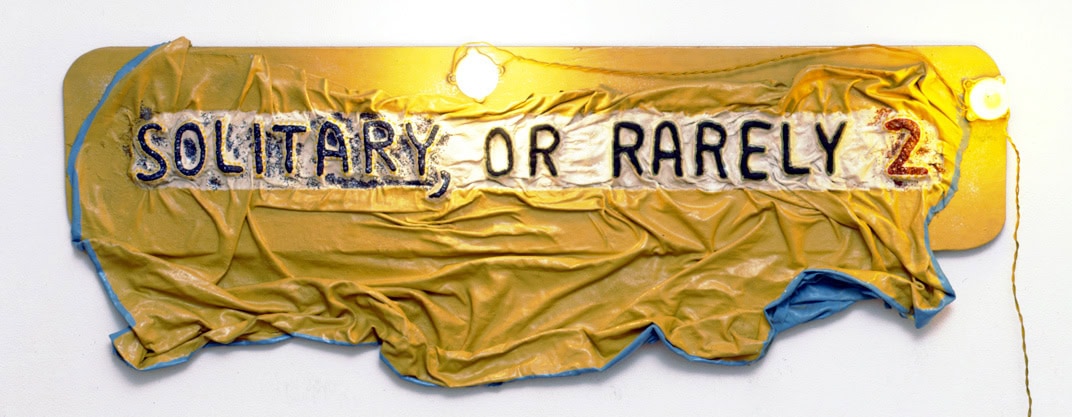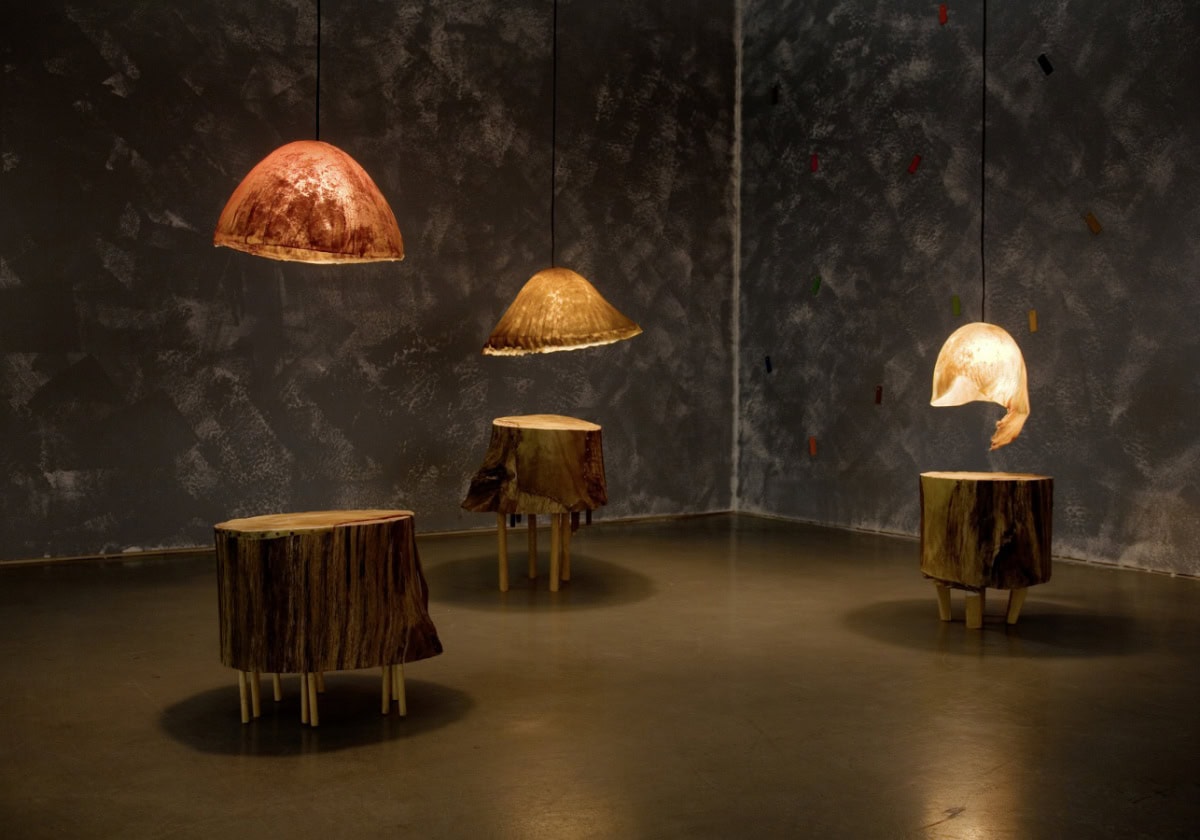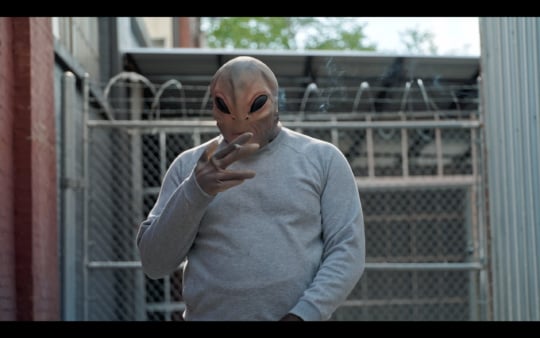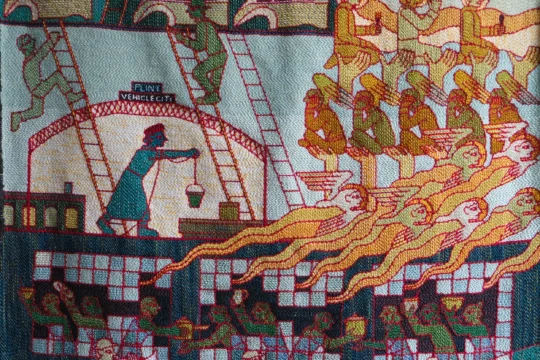
Relation of colors — bright, decorated — contradiction to funerary look/reminder of form — with (sometimes) sadness of the words.
Ree Morton, Black Sketchbook, 1975
A yellow blanket with a blue underside, draped over a yellow board supports the words “SOLITARY, OR RARELY,” written in black, and, in red, “2.” Two bulbs fixed to the board give off a little light, reflecting off of the yellow blanket. But, it isn’t fabric, it’s plastic. The form is reminiscent of a haphazardly arranged banner, or a flag caught mid-unfurling. White surrounds the raised lettering, and in some places the black or red of the text mars its surface. It is a sturdy wall sculpture of wood and plastic, but it is all handmade eccentricity. The work has such vibrance that the existential implications of the text tears through even more cruelly. Solitary, or Rarely 2 (1974) was the first piece that I saw by Ree Morton. It is part of a series of works now known as the Celastics. (Celastic was a favored material of Morton because of its ease in manipulation; it is cloth wrapped in plastic that can be hand-formed when dipped in acetone.)
I was attracted to the vicious twist of the work, Morton’s bright, decorative material choices undercut with the devastating poetics of the text, the tension between the celebratory surface and the piercing nature of her found text. The text and the playful manipulation of its appearance are evidence of Morton’s embrace of the sentimental. The work makes intentional use of being “hazardously close to the commercialized and manipulated emotion of the Hallmark card, the bad romantic comedy, to Mother’s Day.” Morton was a master of showing the truth in both the joyous surface and the (sometimes) sad content of the work; the piece’s perspective is never simplified into one dimension, despite her flirtation with cliché. She believes in both sides.
In a conversation at the Drawing Center, Allan Schwartzman recalled how Ree Morton’s journey away from a male-centered Minimalist abstraction developed in response to a comment from male peers that women should stick to bake sales. She made a sculpture called Bake Sale, real decorative cakes set on a more formal Minimalesque table. This helps explain why Morton found sentimentality so rich for potential exploration. Her visual language and communicative sensibilities conveyed her resistance to both the art world and male-centered careerism.
But this is only part of the truth about Ree Morton’s oeuvre, and it’s the easiest part. The full truth: once released from the constraints of pure formal sculpture, she was able to create work that resonated with her interests and life. While her work was still concerned with materiality and the phenomenology of perception, Morton also made work concerned with literature, emotions, and flowers. Her work was incredibly sensitive and anti-reductive.
Radically preoccupied with contingency, her work’s digressions from the Minimalist tradition were grounded in literature, naturalism, taxonomy, and landscape. These interests were given equal contemplation and treatment. Each element in her work takes on a physical importance. The lights of Solitarily, or Rarely 2 serve not only to illuminate the whole work, they are given physical importance as well. Thoughtfully embedded and left bare, the bulbs and their throw of light are given a physical importance within the work. Not only was shape and placement used strategically, but Morton was particular about the brightness of the bulbs as well; The very character of the light that would invade the rest of the piece was weighed and considered. Everything has a shape, a form, a bodily presence. This is not attention to detail so much as it is a horizontality of process. Her interests, too, received equal treatment. Dancing from wildflowers to philosophy to lived experience, she did not limit her sources of inspiration to one order.

found words – sources outside of oneself in order to get at oneself
Ree Morton, Black Sketchbook, 1975
Solitary, or Rarely is excerpted from Neltje Blanchan’s Wild Flowers Worth Knowing. The text acknowledges other fields of study important to Morton and, extracted and decontextualized, becomes a personalized statement about loneliness and of concern to human experience. Morton drew inspiration from the taxonomy of wild flowers but also was greatly influenced by cult French writer Raymond Roussel and the humanist philosophy of Miguel de Unamuno y Jugo. From the latter, she wrestled the title To Each Concrete Man, latching on to the notion that philosophies, theories, and even art cannot be considered more important than an individual’s full lived experience. A life matters. This wonderfully unpretentious thought is not unimportant or trivial.
Ree Morton was born in 1936 and died of complications from injuries received in a car accident in 1977; she was 40 years old. She studied to become a nurse before finding art and had three kids long before she finished her MFA. I’d like to think that this is where some of her sensitivity came from. And this is where much of her rebellious insistence on values foreign to the art world came from. She was a mother and rightfully took that responsibility seriously. But I also want to celebrate the two years that she sent her children to live with their father so that she could work more productively in New York. She called her reunion with her children the happiest moment of her life; but, all the same, to take some time for yourself is a brave act.
Most of Morton’s successful works were made from 1971 through 1977, barely seven years of working post-graduate school. So little of the work from that time has survived. She frequently would destroy old work to create new work. Her work was also sometimes meant to be ephemeral, as evidenced by the burning of Devil Chaser. The very materials she worked with were not fully archivable. But her art world legacy matters little when compared to imagining her concrete life.




